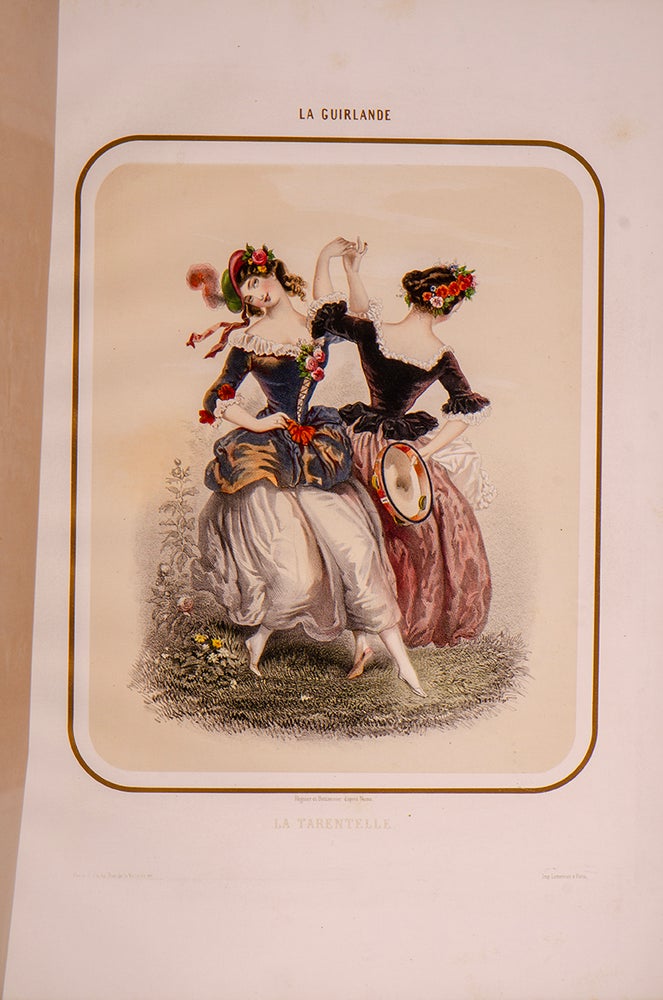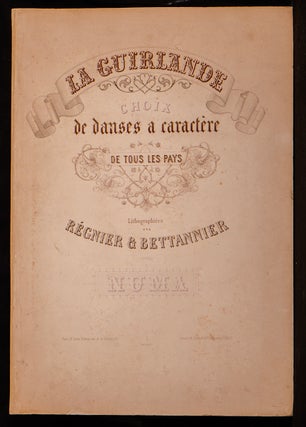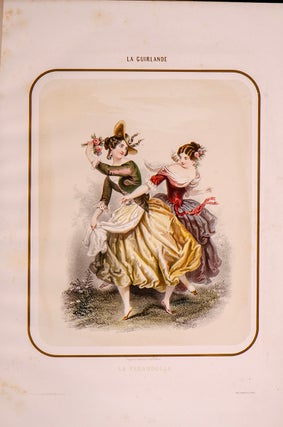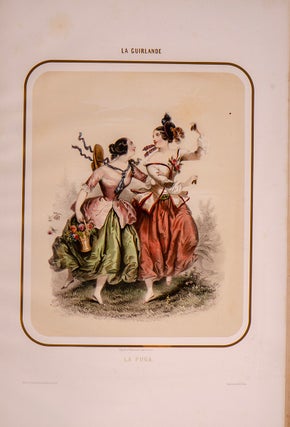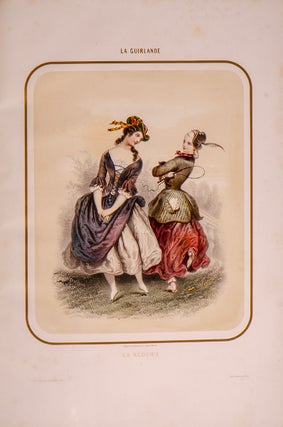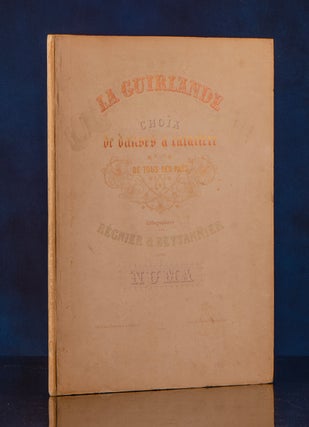La Guirlande choix de Danses a caractère de tous les pays
Paris: Paris: H. Gache [&] London: E. Gambart, 1850. Item #05429
The Traditional Dances of France, Italy, Spain and the Czech Republic
Six Superb Hand Colored Lithograph Plates by Pierre-Numa Bassaget
NUMA (pseudonym of Pierre-Numa BASSAGET). La Guirlande choix de Danses a caractère de tous les pays. Lithographiées par Régnier & Bettannier d'apres Numa. Paris: H. Gache [&] London: E. Gambart, [ca. 1850].
First (only) edition. Large folio (19 5/8 x 13 5/8 inches; 499 x 346 mm.). Six superb hand colored lithograph plates. All plates interleaved, each with a gold border, lithographed by Régnier & Bettannier d'apres Numa, and printed by Lemercier.
Publishers lithographed cream boards, spine expertly and almost invisibly repaired. An exceptionally fine copy in its original binding.
Although other works by Numa are principally related to fancy dress costume and European women's costume, these have an additional dimension, showing as they do the traditional dances of a variety of nationalities, and the costumes of the women participating. These superb hand colored lithographs depict traditional folk dances from France, Spain, Italy and the Czech Republic. The dances include the Fandango, Tarantella and the Bolero.
OCLC locates no copies in libraries and institutions worldwide.
According to ABPC no copies have appeared at auction over the past fifty years…
Pierre-Numa Bassaget, aka Numa (French artist, lithographer & printmaker active 1830-1854). He was a contributor to Le Charivari and La Caricature. He illustrated Costumes Civils et militaires depuis le ve. siècle… [1833-1835] Colas 2228, Hiler, p.68; Fantaisies Gracieuses [1850] Colas 2229; Costumes Cosmopolites [184-?] Colas 2230, Hiler, p. 68; Caricatures anti-cholériques, 1832. Hiler p.68, Lipperheide 3670; La Guirlande choix de Danses a caractère de tous le pays, and Moeurs et Usages (Beraldi X, p.273), all of which are excessively rare.
The Plates:
1. La Farandolle. (A dance from Provence, Southern France)
2. Le Fandango. (An exuberant Spanish courtship dance)
3. La Tarentelle. (Also known as “the dance of the spider,” the Tarantella is derived from the Italian word tarantola, meaning “tarantula.” The tarantola gets its name from the town of Taranto in Puglia, where the bite of the local wolf spider (the tarantula) was widely believed to be highly poisonous and led to a condition known as “tarantism".
4. La Fuga. (A Spanish Dance - The Escape…)
5. Le Bolero. (The Boléro is a slow form of Spanish dance with roots in Spain and Cuba. Contemporary boléro is a hybrid of other Latin and ballroom dances and combines the lilting rise and fall of the waltz, the contra-body movement of tango, and the slow movement and Latin music associated with the rumba.
6. La Rédowa. (A Bohemian dance in two forms, one resembling the waltz or the mazurka, the other resembling the polka. The name comes from the Czech name rejdovák, derived from rej ("whirl"). Originally a folk dance, it first appeared into the salons in Prague in 1829 and fell out of fashion by 1840, though in the meantime it had spread beyond Bohemia. A dance in triple time resembling a waltz.
Bobins III, 1058; Not in Beraldi, Colas, Hiler or Lipperheide.
Price: $9,500.00

 I have been in the rare and antiquarian book business for over forty years; my family has been in the rare books business since 1876. Rare books are in my blood.
I have been in the rare and antiquarian book business for over forty years; my family has been in the rare books business since 1876. Rare books are in my blood.
